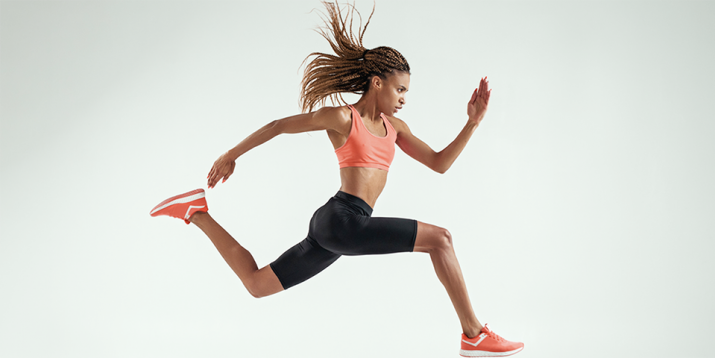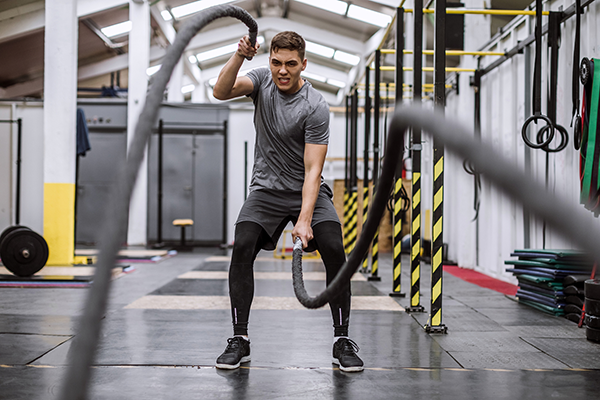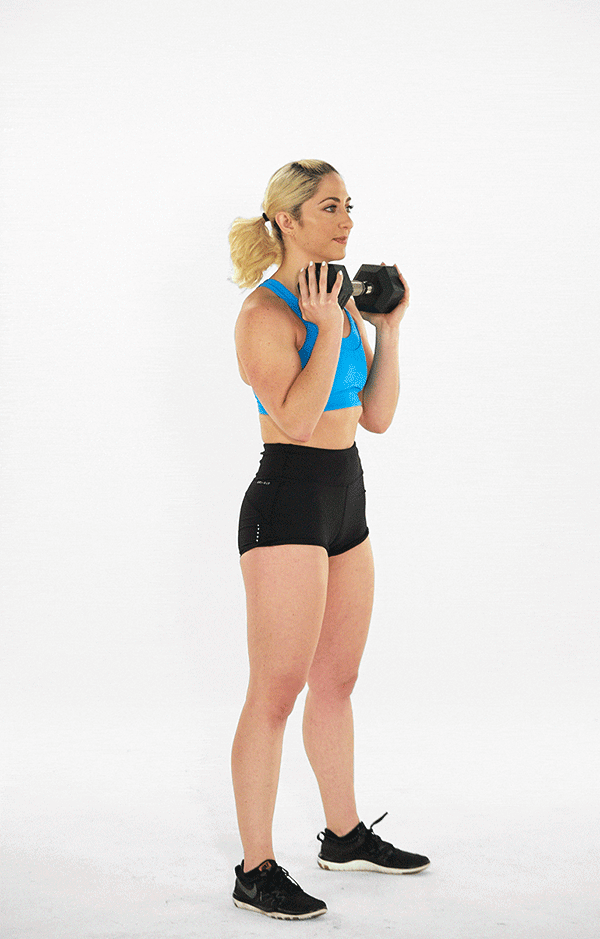Get a Full Workout With an AMRAP Routine

Need a quick-yet-effective sweat session? Then you need to familiarize yourself with AMRAP.
This training style allows you to squeeze loads of reps into a short amount of time — so you can get your workout done and get on with your day.
Here’s how it works.
What Is AMRAP?
AMRAP is a form of interval training. It stands for “as many rounds as possible” or “as many reps as possible,” depending on the format of the workout.
“Typically, the idea is that you perform a circuit or [single] exercise with a specified number of reps, for as many rounds as possible within a given time frame,” says April Whitney, a NASM-certified personal trainer.
For example, you might do a circuit (e.g., 15 reps each of dumbbell squats, push-ups, and V sit-ups) for as many rounds as possible in 15 to 20 minutes, resting as needed.
Or, you could set your timer for 30 seconds and try to complete as many reps of a given exercise as you can before time is up.
How Long Is AMRAP?

The length of an AMRAP workout can vary widely and will depend on whether you’re incorporating it into an existing workout (as a finisher, for example) or doing it as a standalone routine.
It can be as short as 30 seconds of a single exercise, or as long as a 30-minute circuit workout.
“Technically it can be even longer, but that starts to get pretty aggressive,” says Hannah Davis, a certified strength and conditioning specialist.
Will AMRAP Help Me Lose Weight?
Like other forms of interval training, AMRAP burns more calories per minute than traditional steady-state cardio.
“AMRAPs tend to burn more calories due to their higher intensity levels, which can be useful for weight loss in general,” Whitney says.
Plus, many AMRAP workouts incorporate strength exercises, making them a great way to build muscle and improve muscular endurance — and building muscle can help to enhance metabolism.
Is AMRAP Always a Cardio Workout?
AMRAP workouts can spike your heart rate fairly quickly, making them a great option for building cardiovascular fitness.
“But unlike traditional cardio, AMRAP can do an excellent job of building muscle as well,” Davis says.
Why? Because you can use both strength- and cardio-focused exercises in an AMRAP workout, including burpees, push-ups, plyo lunges, and mountain climbers.
Is AMRAP Like HIIT?

It depends. While AMRAP workouts can be intense, they don’t automatically qualify as high-intensity interval training (HIIT).
“AMRAP [typically] includes little to no rest between exercises throughout the duration of the workout, while a HIIT workout should technically include rest periods after extremely intense bouts of exercise,” Davis says.
However, if you structure things right, you can use AMRAP to create a HIIT workout.
The Tabata protocol is a classic example of a HIIT workout that takes advantage of AMRAP.
To do it, simply choose one exercise (typically a cardio exercise like sprints or burpees) and do as many reps as possible in 20 seconds. Rest for 10 seconds, then repeat that work-rest regimen seven times.
How Do I Add AMRAP to My Routine?
There are many ways to take advantage of the cardio-boosting, calorie-torching benefits of AMRAP. “There’s no wrong way to do an AMRAP,” Davis says.
You can either throw in a round of AMRAP at the end of a strength training session, or create a standalone AMRAP workout.
To build a complete AMRAP workout, Whitney suggests choosing one upper body exercise, one lower body exercise, and one core exercise.
Do 10 reps of each exercise back-to-back for as many rounds as possible in six minutes. Rest one minute.
Repeat that circuit another two or three times, or choose new exercises to change up the circuits.
5 Exercises to Add to an AMRAP Workout
Now that you know what AMRAP is and how to do it, here are five moves you can use to create an AMRAP workout.
1. Burpees
- Stand tall with your feet hip-width apart and your arms at your sides.
- Bend your knees, hinge at your hips, and squat down, placing both palms on the floor.
- Jump your feet back to a high plank position, with hands directly beneath your shoulders, core engaged, back straight, hands and the balls of your feet on the floor, and your body straight from head to heels.
- Do a push-up: Bend the elbows to lower your torso until your chest is a few inches from the floor (your elbows should be pointing behind you at about a 45-degree angle), and then quickly push back up.
- Jump your feet back to your hands, and then explode upward, jumping into the air.
- Land softly with knees slightly bent and immediately begin your next rep.
Appears in T-MINUS 30.
2. Push-up
- Start in a high plank position with your feet together, your hands in line with (but slightly wider than) your shoulders, and your body straight from head to heels. Clench your glutes and brace your core to lock your body into position.
- Keeping your head down and your elbows angled about 45 degrees from your body, lower your chest to within a few inches of the floor.
- Pause, and then push yourself back up to the starting position as quickly as possible.
3. Reverse lunge with rotation
- Stand with your feet hip-width apart, holding a single dumbbell in both hands in front of you with your elbows by your sides. This is the starting position.
- Keeping your chest up, back flat, shoulders back, and core engaged, take a large step back with your left leg.
- Lower your body until your right thigh is parallel with the floor. Your right knee should be tracking directly above the ankle, and knees should be bent about 90 degrees, with the left knee hovering a couple of inches above the ground.
- Rotate your torso to the right, bringing the dumbbell toward your right hip.
- Reverse the entire movement and return to the starting position.
- Repeat, this time stepping back with your right leg and rotating your torso to the left.
- Continue alternating sides.
Appears in Abs + Booty Burn with Jordan Morello.
4. Dumbbell swing
- Stand tall with your feet shoulder-width apart, holding one end of a dumbbell in both hands, interlacing your fingers to make sure your grip is secure.
- Keeping your back flat, arms straight, and core engaged, push your hips back and swing the dumbbell between your legs. Your knees should be slightly bent as hips hinge.
- Now squeeze your glutes and explode up, swinging the dumbbell to shoulder level.
- Swing the dumbbell back between your legs to begin your next rep.
Appears in Strong + Solid With Lita Lewis.
5. Dumbbell jump squat

- Stand tall with your feet shoulder-width apart. Hold a dumbbell in front of your chest with both hands.
- Keeping your chest up, core engaged, and back flat, bend your knees, push your hips back and lower your body until your thighs are parallel to the floor.
- Push yourself back up explosively, jumping straight up.
- Land softly with knees slightly bent, lowering yourself immediately into your next rep.
